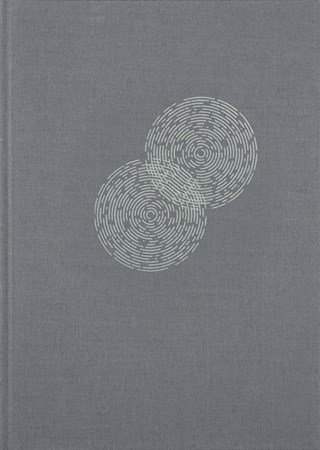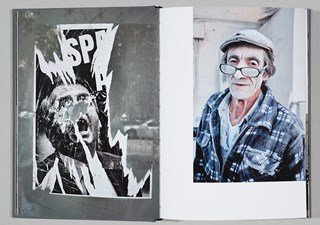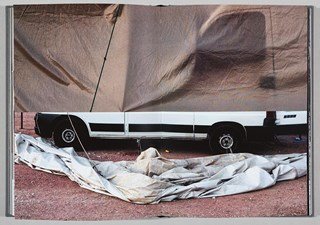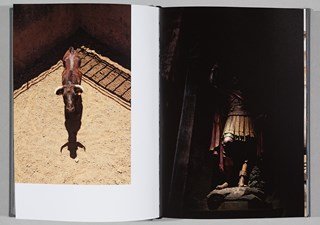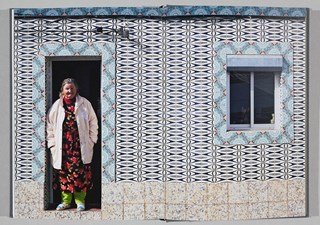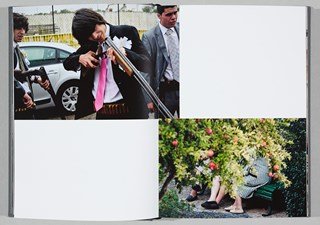Istmo / Pedro S. Lobo
Tereza Siza: “This is the role of this work by Pedro Lobo; to combine the labyrinthine fragments of life through the gaze of one who has learned to seek the symbology of gestures, of spirit and of the inevitably subjective representation of the multiplicity and disorder.”
As we discuss gaze, what really matters is its construction as the vision is developed, becoming part of the photographer. The experiencialism, in aesthetics, in form and in meaning, molds the gaze and the organization of a given project. That’s what we see here, what the photographer produced and transmitted, in abstract or graphic form, looking at the world in his own way (be it in fabrics where modules are repeated like tiles, in series or sequences, be it in the framing of chequered shirts of incautious men, confined by the edges of the frame). Pedro Lobo has already brought us many beautiful images. He doesn’t forget it in this collection, and he also collects aesthetic moments that a non-aesthetic Nature provides. But the majority of the humanness here is indefinable and enigmatic - it’s the life of others, that follow a path we only pretend to understand. They might be remembered in dated cadres, or domestic photography series, in the context of the critical anti-photography of the last quarter of the 20th Century; here they are still memory witnesses, subjective things that feed spaces and decisions. In the same way, the images of messy arrangements, cupboards and wardrobes, coat hangers and other instances of a deep-felt social gaze. But always, the subjective light over reality and its symbols, of labour and days, of the lot that made has made, the gothic cathedral, the doll in plastic and the mannequin, the clothes on the hanger, the dome or the airplane, the rocky road or that domesticated but rebellious goat.
Tereza Siza, a photographer and art critic, Matosinhos, Portugal.
Tereza Siza: “This is the role of this work by Pedro Lobo; to combine the labyrinthine fragments of life through the gaze of one who has learned to seek the symbology of gestures, of spirit and of the inevitably subjective representation of the multiplicity and disorder.”
As we discuss gaze, what really matters is its construction as the vision is developed, becoming part of the photographer. The experiencialism, in aesthetics, in form and in meaning, molds the gaze and the organization of a given project. That’s what we see here, what the photographer produced and transmitted, in abstract or graphic form, looking at the world in his own way (be it in fabrics where modules are repeated like tiles, in series or sequences, be it in the framing of chequered shirts of incautious men, confined by the edges of the frame). Pedro Lobo has already brought us many beautiful images. He doesn’t forget it in this collection, and he also collects aesthetic moments that a non-aesthetic Nature provides. But the majority of the humanness here is indefinable and enigmatic - it’s the life of others, that follow a path we only pretend to understand. They might be remembered in dated cadres, or domestic photography series, in the context of the critical anti-photography of the last quarter of the 20th Century; here they are still memory witnesses, subjective things that feed spaces and decisions. In the same way, the images of messy arrangements, cupboards and wardrobes, coat hangers and other instances of a deep-felt social gaze. But always, the subjective light over reality and its symbols, of labour and days, of the lot that made has made, the gothic cathedral, the doll in plastic and the mannequin, the clothes on the hanger, the dome or the airplane, the rocky road or that domesticated but rebellious goat.
Tereza Siza, a photographer and art critic, Matosinhos, Portugal.
Tereza Siza: “This is the role of this work by Pedro Lobo; to combine the labyrinthine fragments of life through the gaze of one who has learned to seek the symbology of gestures, of spirit and of the inevitably subjective representation of the multiplicity and disorder.”
As we discuss gaze, what really matters is its construction as the vision is developed, becoming part of the photographer. The experiencialism, in aesthetics, in form and in meaning, molds the gaze and the organization of a given project. That’s what we see here, what the photographer produced and transmitted, in abstract or graphic form, looking at the world in his own way (be it in fabrics where modules are repeated like tiles, in series or sequences, be it in the framing of chequered shirts of incautious men, confined by the edges of the frame). Pedro Lobo has already brought us many beautiful images. He doesn’t forget it in this collection, and he also collects aesthetic moments that a non-aesthetic Nature provides. But the majority of the humanness here is indefinable and enigmatic - it’s the life of others, that follow a path we only pretend to understand. They might be remembered in dated cadres, or domestic photography series, in the context of the critical anti-photography of the last quarter of the 20th Century; here they are still memory witnesses, subjective things that feed spaces and decisions. In the same way, the images of messy arrangements, cupboards and wardrobes, coat hangers and other instances of a deep-felt social gaze. But always, the subjective light over reality and its symbols, of labour and days, of the lot that made has made, the gothic cathedral, the doll in plastic and the mannequin, the clothes on the hanger, the dome or the airplane, the rocky road or that domesticated but rebellious goat.
Tereza Siza, a photographer and art critic, Matosinhos, Portugal.
Photographs: Pedro S. Lobo
Texts: Christian Carvalho Cruz
Concept and Editorial Coordination: Rosely Nakagawa Conceito e projeto gráfico
Concept and Graphic Design: Gabriel Zellmeister
English Translation: Ricardo Sternberg Copydesk & Ana Carolina Ramos
Proofreading: Anaelena Lima
Art work: Mario Ferraz Jr
Graphic Production: Maiadouro
2022
208 pages
17,6 x 24,6 cm
First edition
Edition of 600
Portuguese and english texts
ISBN: 978-989-568-052-8

